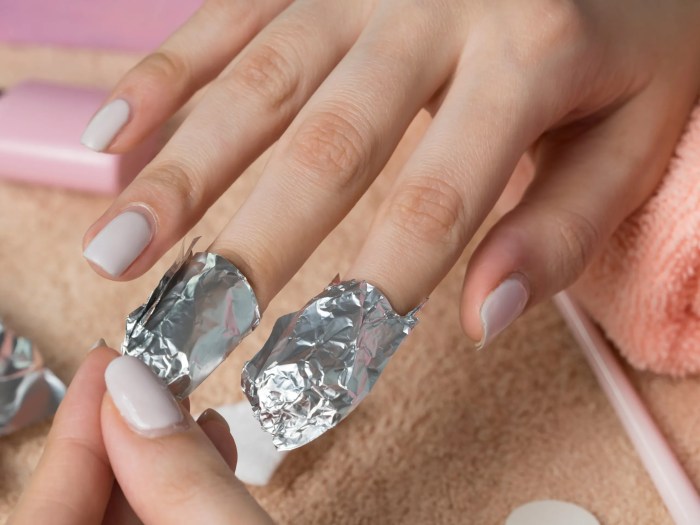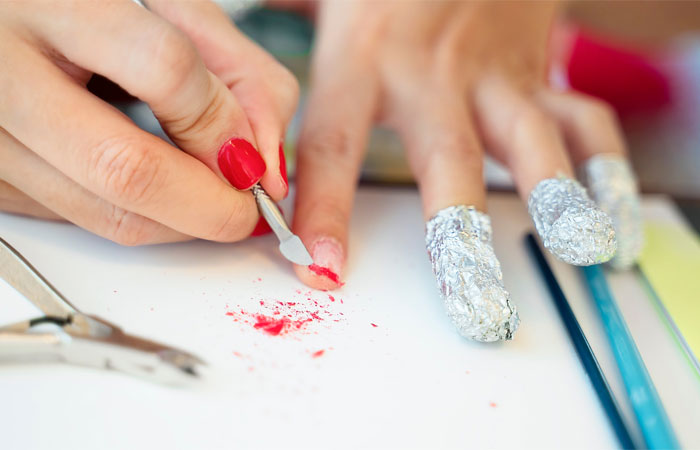Get Gel Nail Polish Off Safely
Safe Gel Nail Polish Removal Methods
Get gel nail polish off – Removing gel nail polish safely and effectively requires careful attention to technique and the use of appropriate products. Improper removal can lead to significant damage to your natural nails, including thinning, weakening, and even infection. This section details safe methods for gel polish removal, both at home and professionally.
Acetone Soak-Off Method
The acetone soak-off method is a common at-home technique. It involves soaking your nails in acetone to dissolve the gel polish. Safety precautions are crucial to minimize skin and nail damage.
- Gather your supplies: acetone, cotton balls or pads, aluminum foil, cuticle pusher, nail file, and cuticle oil.
- Prepare your nails: Gently file the top layer of the gel polish to create a rough surface for better acetone penetration. Avoid excessive filing, which can thin your natural nails.
- Apply acetone-soaked cotton pads: Place a cotton pad saturated with acetone on each nail, ensuring complete coverage of the gel polish.
- Wrap with foil: Secure each cotton pad with a small piece of aluminum foil, creating a tight seal to prevent acetone evaporation and enhance penetration.
- Soak: Allow the acetone to soak for 10-15 minutes, or until the gel polish softens. You may need to reapply acetone if necessary.
- Remove foil and cotton pads: Carefully remove the foil and cotton pads. Gently push off the softened gel polish with a cuticle pusher. Avoid excessive force, which can damage your natural nails.
- Clean and moisturize: Cleanse your nails with a gentle nail polish remover and apply cuticle oil to rehydrate your nails and cuticles.
Safety Precautions: Always work in a well-ventilated area to avoid inhaling acetone fumes. Avoid prolonged skin contact with acetone, as it can cause dryness and irritation. If you experience any burning or discomfort, immediately remove the acetone and rinse your nails with water.
E-File Method
Professional e-files offer a faster and potentially less damaging alternative to the acetone soak-off method. However, improper use can lead to significant nail damage. Professional training is highly recommended.
- File the top layer of the gel polish to create a rough surface for the e-file to grip.
- Using a low-speed setting and gentle pressure, carefully file away the gel polish in thin layers. Avoid excessive pressure, which can damage the natural nail.
- Regularly clean the e-file bit to prevent clogging and ensure even removal.
- Once the gel polish is removed, buff the nail surface gently to smooth any imperfections.
- Apply cuticle oil to hydrate and nourish the nails.
Safety Measures: Only use e-files with appropriate bits and settings. Avoid excessive pressure or speed, which can cause damage to the natural nail. Proper training is crucial for safe and effective e-file use.
Acetone Soak-Off vs. E-File: A Comparison
Both methods have advantages and disadvantages. The acetone soak-off method is less expensive and can be done at home, but it’s more time-consuming and may be more damaging to the nails if not done correctly. The e-file method is faster and potentially less damaging with proper technique, but requires professional training and specialized equipment.
| Method | Time | Cost | Potential Damage |
|---|---|---|---|
| Acetone Soak-Off | 30-45 minutes | Low | Moderate (if done incorrectly) |
| E-File | 15-20 minutes | High (due to equipment cost and potential professional fees) | Low (with proper technique and training) |
The Role of Foil Wraps in Acetone Removal
Aluminum foil wraps are essential for effective acetone soak-off. They create an airtight seal, preventing acetone evaporation and ensuring maximum penetration to dissolve the gel polish. Proper application involves carefully wrapping the foil around each nail, ensuring a tight seal to prevent leakage.
Comparison of Acetone-Based Removers
Various acetone-based removers are available, differing in price, formulation, and user reviews. Choosing a high-quality remover can improve the removal process and minimize nail damage.
| Brand | Price Range | User Reviews (Example) |
|---|---|---|
| Brand A | $5-$10 | Generally positive, some users report dryness. |
| Brand B | $10-$15 | Highly rated, known for effectiveness and gentleness. |
| Brand C | $15-$20 | Mixed reviews, some users report strong odor. |
| Brand D | $20+ | Premium quality, known for fast and efficient removal. |
Home Remedies and Alternatives
While acetone is the most effective method for removing gel nail polish, several home remedies can help soften the polish, making removal easier. However, these methods may not be as effective as acetone and should be used with caution.
Softening Gel Polish with Home Remedies
Several household items can assist in softening gel polish before removal. However, their effectiveness varies, and they may not be suitable for all types of gel polish.
- Warm Water Soak: Soaking nails in warm water can slightly soften the gel polish, but it’s generally less effective than acetone.
- Olive Oil: Applying olive oil to the nails and letting it sit for a while can help to soften the gel polish. However, it’s not as effective as acetone and may take longer.
- Baking Soda Paste: A paste of baking soda and water can be applied to the nails and gently scrubbed to help remove the gel polish. However, it may be abrasive and potentially damage the nails.
Using Cuticle Oil
Cuticle oil is beneficial for nail health, and applying it after gel polish removal helps to rehydrate and nourish the nails and cuticles. While it doesn’t directly remove the gel polish, it can improve the overall condition of the nails after the removal process.
Risks of Using Household Items
Using household items not intended for nail polish removal can lead to nail damage, irritation, or allergic reactions. Avoid using abrasive materials or harsh chemicals that may damage your natural nails or surrounding skin.
Household Items for Removal
- Cotton balls or pads
- Aluminum foil
- Cuticle pusher
- Nail file
Comparison of Non-Acetone Removers
Non-acetone removers are gentler on nails than acetone-based removers but may be less effective at removing gel polish. Their effectiveness varies depending on the type of gel polish and the remover’s formulation.
Preventing Nail Damage: Get Gel Nail Polish Off
Proper nail preparation before applying gel polish and diligent aftercare are crucial for minimizing damage during removal. Following these steps can help maintain healthy, strong nails.
Nail Preparation Before Gel Application
Proper preparation minimizes damage during removal. This includes gently pushing back cuticles, ensuring nails are clean and dry, and avoiding excessive filing or buffing of the natural nail plate before applying the base coat.
Post-Removal Nail Care
After gel polish removal, it’s essential to nurture your nails back to health. This involves hydrating with cuticle oil, avoiding harsh chemicals, and giving your nails a break from polish.
Nail Strengthening Products and Treatments
- Nail strengtheners
- Biotin supplements
- Cuticle oil
- Nail growth serums
Signs of Nail Damage and Treatment

Source: self.com
Signs of nail damage include thinning, weakening, discoloration, or brittleness. Treatment involves using nail strengtheners, cuticle oil, and avoiding harsh chemicals or practices that may further damage the nails.
Correct Filing and Buffing
Gently filing and buffing the nails after gel polish removal can smooth any imperfections without causing further damage. Avoid excessive pressure or harsh movements that can thin or weaken the nails.
Professional Removal vs. DIY
Choosing between professional and DIY gel polish removal depends on several factors, including cost, convenience, and the potential for nail damage. Each method has its advantages and disadvantages.
Cost Comparison, Get gel nail polish off
Professional gel polish removal is generally more expensive than DIY methods, but it reduces the risk of nail damage from improper techniques. The cost varies depending on the salon and location.
Benefits and Drawbacks of Professional Removal
Professional removal offers expertise and minimizes the risk of nail damage. However, it is more expensive and requires scheduling an appointment. DIY methods are cheaper and more convenient, but they carry a higher risk of damaging nails if done incorrectly.
Situations Where Professional Removal is Recommended

Source: salonrates.com
Professional removal is recommended when you have sensitive nails, experience difficulty removing gel polish at home, or notice signs of nail damage after DIY removal. It is also preferable for complex designs or thick gel applications.
Professional Experience and Training
Professionals undergo training to use appropriate tools and techniques to remove gel polish safely and effectively, minimizing the risk of nail damage. They have access to specialized equipment, such as e-files, which can remove gel polish more efficiently and with less potential damage.
Professional vs. DIY: Advantages and Disadvantages
| Feature | Professional Removal | DIY Removal |
|---|---|---|
| Cost | Higher | Lower |
| Convenience | Less convenient (requires appointment) | More convenient (can be done at home) |
| Risk of Damage | Lower (with experienced technician) | Higher (if done incorrectly) |
| Time | Faster (typically) | Slower |
Illustrative Examples
Visual cues can help identify healthy nails versus those damaged by improper gel polish removal. Understanding these differences can guide safe removal practices.
Healthy vs. Damaged Nails
Healthy nails are smooth, even in color, and have a consistent thickness. Damaged nails may be thin, brittle, discolored (yellowed or white), or have a rough texture. They may also exhibit peeling or separation from the nail bed.
Correctly vs. Incorrectly Applied Acetone Wraps
Correctly applied acetone wraps completely cover the nail with a saturated cotton pad, sealed tightly with foil to prevent acetone evaporation. Incorrectly applied wraps may have gaps, allowing acetone to escape and reducing effectiveness. They may also be loosely wrapped, leading to uneven removal.
Visual Changes During Acetone Soak-Off
Initially, the gel polish appears unchanged. As the acetone penetrates, the gel begins to soften and lift slightly from the nail bed. Over time, the gel will become noticeably softer and easier to remove with a cuticle pusher. The color may become slightly lighter or duller as the gel dissolves.
Proper E-File Use
Proper e-file use involves using a low-speed setting and light pressure, moving the file across the nail surface in a smooth, controlled motion. Avoid applying excessive pressure or lingering in one spot, which can cause damage. The file should gently remove thin layers of gel polish without damaging the natural nail.
Question Bank
Can I use regular nail polish remover to remove gel polish?
No, regular nail polish remover is not strong enough to dissolve gel polish. You need an acetone-based remover.
How often should I remove my gel polish?
It’s generally recommended to remove gel polish every 2-3 weeks to prevent damage to your natural nails. Leaving it on for longer can weaken the nails.
What if my nails are sensitive or thin?
If you have sensitive or thin nails, opt for the acetone soak-off method over the e-file, and use a high-quality cuticle oil afterwards to strengthen them.
Removing gel nail polish can be tricky, often requiring soaking and scraping. If you’re looking for gentler alternatives to harsh acetone-based removers, consider exploring other options. For instance, you might find helpful information on suitable substitutes in this article: what can be used instead of nail polish remover. Knowing what else works well can make the whole process of getting rid of that stubborn gel polish much easier on your nails.
My gel polish is lifting – can I still remove it at home?
Yes, but proceed with caution. The lifting makes the process easier, but be careful not to damage your nails during removal. Take your time and use gentle techniques.





















